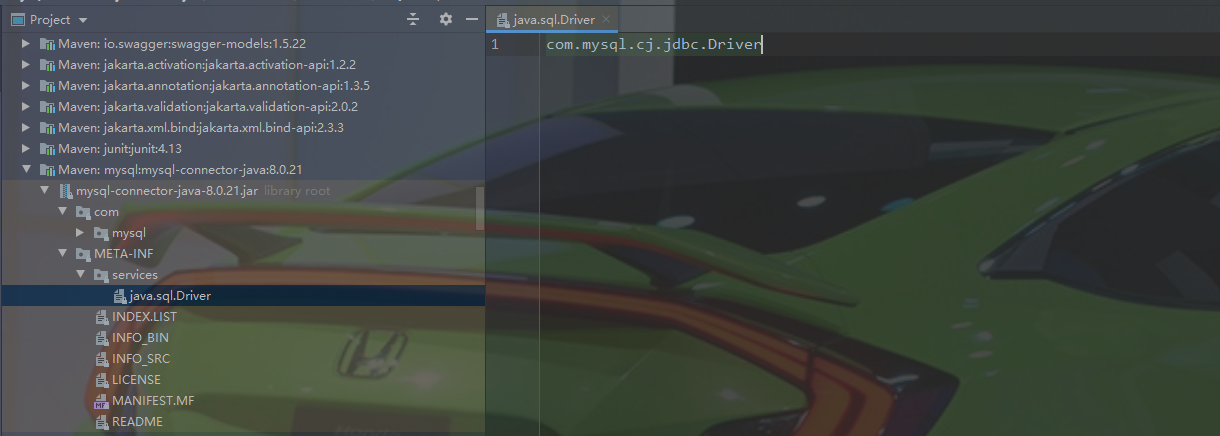1.什么是spi?
SPI 全称为 (Service Provider Interface) ,是JDK内置的一种服务提供发现机制。SPI是一种动态替换发现的机制, 比如有个接口,想运行时动态的给它添加实现,你只需要添加一个实现。我们经常遇到的就是java.sql.Driver接口,其他不同厂商可以针对同一接口做出不同的实现,mysql和postgresql都有不同的实现提供给用户,而Java的SPI机制可以为某个接口寻找服务实现。

如上图所示,接口对应的抽象SPI接口;实现方实现SPI接口;调用方依赖SPI接口。
SPI接口的定义在调用方,在概念上更依赖调用方;组织上位于调用方所在的包中,实现位于独立的包中。
当服务的提供者提供了一种接口的实现之后,需要在classpath下的META-INF/services/目录里创建一个以服务接口命名的文件,这个文件里的内容就是这个接口的具体的实现类。当其他的程序需要这个服务的时候,就可以通过查找这个jar包(一般都是以jar包做依赖)的META-INF/services/中的配置文件,配置文件中有接口的具体实现类名,可以根据这个类名进行加载实例化,就可以使用该服务了。JDK中查找服务实现的工具类是:java.util.ServiceLoader。
2.spi的用途
数据库DriverManager、Spring、ConfigurableBeanFactory等都用到了SPI机制,这里以数据库DriverManager为例,看一下其实现的内幕。
DriverManager是jdbc里管理和注册不同数据库driver的工具类。针对一个数据库,可能会存在着不同的数据库驱动实现。我们在使用特定的驱动实现时,不希望修改现有的代码,而希望通过一个简单的配置就可以达到效果。 在使用mysql驱动的时候,会有一个疑问,DriverManager是怎么获得某确定驱动类的?
先来看看我们平时用的Class.forName("com.mysql.jdbc.Driver")方法,该方法在此处返回com.mysql.jdbc.Driver对象,并执行其中的静态方法把driver注册到DriverManager中,以便后续的使用。
driver实现
package com.mysql.jdbc; import java.sql.DriverManager; import java.sql.SQLException; public class Driver extends NonRegisteringDriver implements java.sql.Driver { public Driver() throws SQLException { } static { try { DriverManager.registerDriver(new Driver()); } catch (SQLException var1) { throw new RuntimeException("Can't register driver!"); } } }
驱动的类的静态代码块中,调用DriverManager的注册驱动方法new一个自己当参数传给驱动管理器。
jdk中
/** * Load the initial JDBC drivers by checking the System property * jdbc.properties and then use the {@code ServiceLoader} mechanism */ static { loadInitialDrivers(); println("JDBC DriverManager initialized"); }
private static void loadInitialDrivers() {
String drivers;
try {
drivers = AccessController.doPrivileged(new PrivilegedAction<String>() {
public String run() {
return System.getProperty("jdbc.drivers");
}
});
} catch (Exception ex) {
drivers = null;
}
// If the driver is packaged as a Service Provider, load it.
// Get all the drivers through the classloader
// exposed as a java.sql.Driver.class service.
// ServiceLoader.load() replaces the sun.misc.Providers()
AccessController.doPrivileged(new PrivilegedAction<Void>() {
public Void run() {
ServiceLoader<Driver> loadedDrivers = ServiceLoader.load(Driver.class);
Iterator<Driver> driversIterator = loadedDrivers.iterator();
/* Load these drivers, so that they can be instantiated.
* It may be the case that the driver class may not be there
* i.e. there may be a packaged driver with the service class
* as implementation of java.sql.Driver but the actual class
* may be missing. In that case a java.util.ServiceConfigurationError
* will be thrown at runtime by the VM trying to locate
* and load the service.
*
* Adding a try catch block to catch those runtime errors
* if driver not available in classpath but it's
* packaged as service and that service is there in classpath.
*/
try{
while(driversIterator.hasNext()) {
driversIterator.next();
}
} catch(Throwable t) {
// Do nothing
}
return null;
}
});
println("DriverManager.initialize: jdbc.drivers = " + drivers);
if (drivers == null || drivers.equals("")) {
return;
}
String[] driversList = drivers.split(":");
println("number of Drivers:" + driversList.length);
for (String aDriver : driversList) {
try {
println("DriverManager.Initialize: loading " + aDriver);
Class.forName(aDriver, true,
ClassLoader.getSystemClassLoader());
} catch (Exception ex) {
println("DriverManager.Initialize: load failed: " + ex);
}
}
}
先查找jdbc.drivers属性的值,然后通过SPI机制查找驱动,并且在上述源码中
注释有这么一句“Load these drivers, so that they can be instantiated.” 意思是加载SPI扫描到的驱动来触发他们的初始化。即触发他们的static代码块
public final class ServiceLoader<S>
implements Iterable<S>
{
private static final String PREFIX = "META-INF/services/";
最后我们再来看下mysql-connector.jar包下的文件,有图有真相:


文件名为jdk下的java.sql.driver接口的全限定名,文件内容为mysql驱动包下的实现类com.mysql.cj.jdbc.Driver